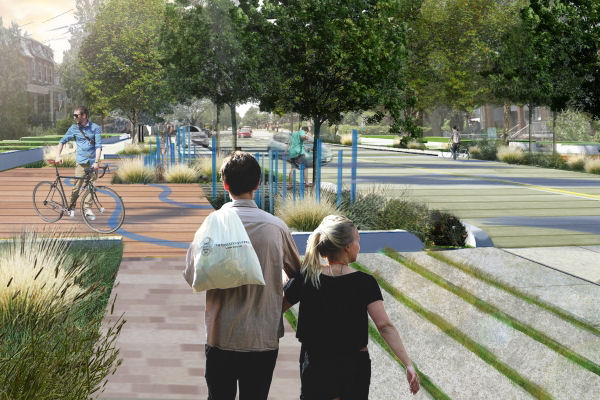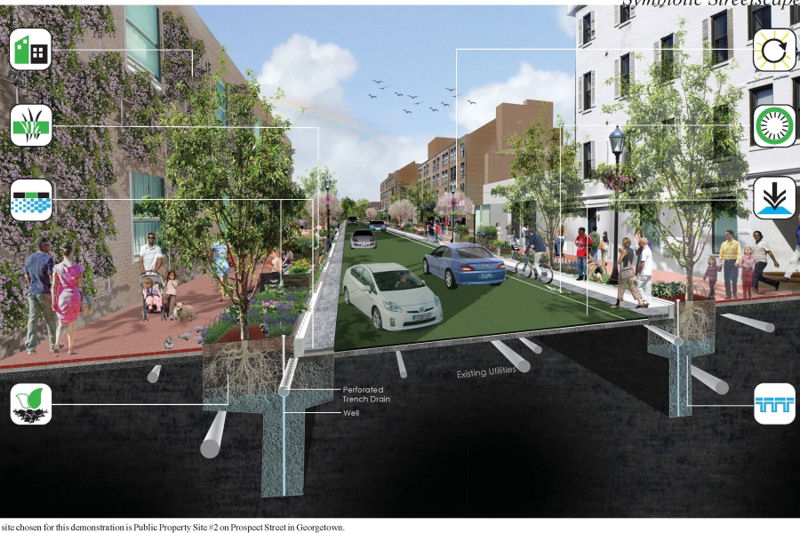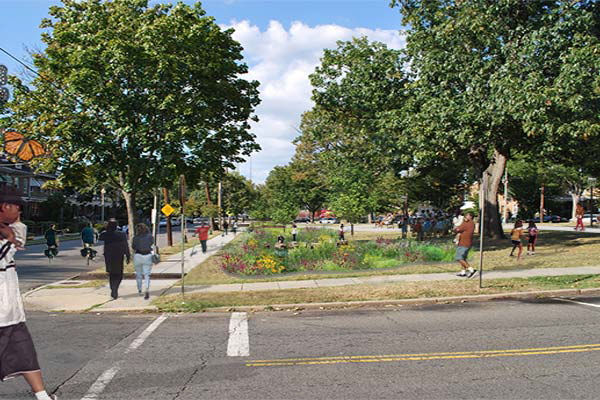
Urban Rain Design (Portland, Ore.) submited this design for a green street to DC Water’s (Washington, D.C.) Green Infrastructure Challenge. It was one of seven winning projects for the first phase of the challenge. Photo courtesy of DC Water.
Building infrastructure to handle stormwater no longer needs to focus on gray, it also can be green. To provide incentives for greening open spaces, streets, roofs, pavement, and bioretention facilities as a way to manage stormwater, DC Water (Washington, D.C.) launched the Green Infrastructure Challenge in April 2013. In January 2014, the utility announced seven projects as winners of the challenge’s first phase, according to a DC Water news release.
The challenge asked any organization to develop innovative and practical green infrastructure solutions for Washington, D.C. Accepted entries included green designs for public spaces, commercial and private properties, and government or institutional properties. The challenge was launched to promote innovative, green infrastructure solutions so that stormwater can be absorbed before making its way into the wastewater or stormwater system. Stopping the runoff helps improve the health of local waterways by reducing the potential for combined sewer overflow (CSO) from heavy rainfall, the news release says.

Projects included detailed ways to prevent stormwater from causing combined sewer overflows during heavy rainfall. This winning design by McKissack & McKissack (Washington, D.C.) shows underground stormwater storage areas. Photo courtesy of DC Water.
“DC Water is educating the community about green infrastructure, communicating widely, and incentivizing those in the field to generate creative and innovative approaches. We look forward to final projects that will serve to green this city, motivate others, and create a body of research that will benefit cities worldwide,” said George S. Hawkins, DC Water general manager.
The winning projects presented innovative plans for collecting water on rooftops, installing bioretention facilities, laying permeable pavement, and implementing a green streetscape in the Potomac River and Rock Creek drainage areas of Washington, D.C. The challenge’s first phase was the design component. A subset of the winning projects will be awarded additional funds for construction as part of the second phase, according to the Green Infrastructure Challenge website. More than $1 million will be awarded for both phases to the winning projects.
The phase one winners include:
- 21st Century Stormwater Management in a 19th Century Neighborhood, by AECOM (Los Angeles),
- Greening the District’s Geometry: Enhancing L’Enfant’s Plan, by CH2M Hill (Englewood, Colo.),
- Kennedy I Greened: A Neighborhood Green Street Project, by Urban Rain Design (Portland, Ore.),
- Lamont Park: Integrating Green Infrastructure and Bike Infrastructure, by Tetra Tech (Pasadena, Calif.),
- A Stormwater Park System, by Bradley Site Design (Washington, D.C.),
- Symbiotic Streetscapes, by McKissack & McKissack (Washington, D.C.), and
- Utilizing Lost Urban Space, by ARCADIS (Highlands Ranch, Colo.).

Designs incorporate rooftop water collection, bioretention techniques, permeable pavement, and green streetscapes. This winning design by CH2M Hill (Englewood, Colo.) adds stormwater retention areas to a public space. Photo courtesy of DC Water.
The challenge is part of DC Water’s Clean Rivers Project and associated efforts to reduce CSOs. In December 2012, D.C. Mayor Vincent Gray, U.S. Environmental Protection Agency Region 3 Administrator Shawn Garvin, and Hawkins signed the Clean Rivers, Green District Partnership Agreement outlining a pilot green infrastructure program, which is the program that hosted the 2013 challenge, according to DC Water’s Low Impact Development website.
— Jennifer Fulcher, WEF Highlights








February 20, 2014
Featured